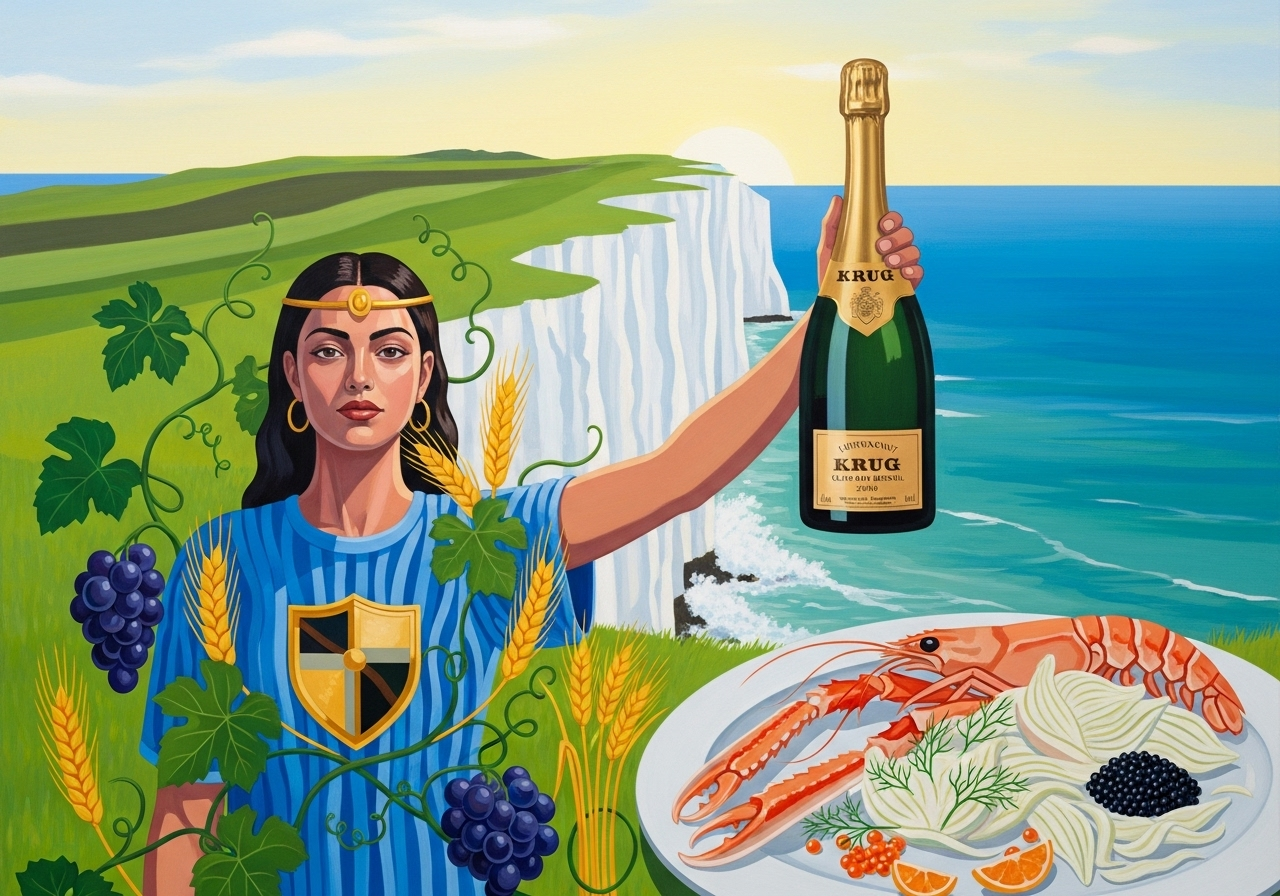The Whispering Walls of Le Mesnil: Krug Clos du Mesnil 2008
Geshtinanna’s lyrical guide to Krug Clos du Mesnil 2008 food pairing—langoustine, truffle, and alpine salt in harmony with chalk and time.

The cork releases like an exhale—a sigh of patience, not performance. I pour the 2008 Clos du Mesnil into a tall, narrow tulip, chilled to 10 °C, and watch the bubbles form a fine, disciplined column. They rise as if drawn upward by memory itself. A brief decant—just enough to loosen its edges—reveals aromas that unfold like parchment: Meyer lemon, almond blossom, sea spray, and the faintest ghost of toasted grain. The mousse is gossamer; the acidity, electric. I sip, and time folds inward. The goddess within the glass stirs, remembering the long sleep of chalk and frost from which she was born.
The Sacred Enclosure
The Clos du Mesnil vineyard, barely 1.84 hectares, lies walled at the heart of Le Mesnil‑sur‑Oger, in Champagne’s Côte des Blancs. Here, Chardonnay grows on chalk so pale it seems to glow at dusk. Krug’s cellar masters have tended this plot since 1971, their philosophy one of restraint—letting soil and season speak louder than oak or artifice. The 2008 vintage was a cool whisper after years of heat: late ripening, crystalline fruit, and acid like the ringing of glass. France at its most austere and most articulate. A single vineyard, a single grape, a single voice of purity.
Stone, Air, and Pulse
In the glass, Clos du Mesnil 2008 is all architecture and breath. Lemon oil, white peach, crushed shell, and faint smoke rise in sequence, disciplined yet sensuous. The palate vibrates between two poles—razor‑sharp acidity and deep creaminess—an alchemy achieved only by time and patient lees contact. Notes of hazelnut and kumquat, a salt‑licked finish that lingers like tidewater retreating. Its body is sinew, not flesh; its beauty, tensile and precise. This is a Champagne that speaks in geometry and echo. Drink now for brilliance, or let it unfurl until 2040, when its edges will have softened into silk.
When the Sea Meets the Star
Clos du Mesnil’s precision calls for food born of motion and restraint. I begin, as I always have, with the sea—the place where salt and life entwine. Try a dish of Brittany langoustine lightly poached in seaweed butter, served beside shaved fennel and citrus zest. The sweetness of the shellfish teases out the wine’s quiet depth, while its brine matches the chalk’s own saline hum. Or a sliver of turbot roasted on the bone, finished with beurre blanc infused with kombu—the marine umami wraps itself around the Champagne’s mineral drive, a dialogue between ocean and stone.
Then to the earth. Roast guinea fowl glazed with honey and juniper, accompanied by slow‑cooked salsify, speaks to the wine’s paradox of austerity and generosity. The caramelization mirrors its nuttiness; the herb oil draws out its floral whisper. I once poured this pairing under a moon of harvest, when the vines had begun their descent into rest. The air smelled of chalk dust and fading leaves. Even the gods fell quiet to listen.
Gardens Beneath the Frost
Vegetarian pairings demand imagination, not compromise. The Clos du Mesnil 2008 sings beside a Jerusalem artichoke velouté laced with brown butter and truffle foam—earth meeting air, root answering chalk. Or a tart of celeriac and black garlic, its sweetness coaxed to the edge of bitterness. The Champagne’s acidity slices through the richness, restoring balance as the sap returns to the vine. These are not side dishes but meditations—each bite a prayer to the cycle of decay and rebirth that I, Geshtinanna, know too well.
Of Cheese, Salt, and Memory
For the final act, abandon dessert. The wine refuses sugar. Instead, let it converse with aged Beaufort d’Alpage or a sliver of Abbaye de Cîteaux, both carrying the scent of alpine flowers and salt. The Champagne’s taut line of acidity sharpens the cheeses’ cream, while the faint oxidative note—almond, brioche, candle smoke—wraps them in warmth. If you must indulge, a tiny spoon of osetra caviar on blini does not offend the gods.
The Goddess and the Wall
When I walk the Clos, I feel the memory of my own descent—the long winters underground, the hum of sap beneath stone. Each vine is a verse in a hymn of patience. In Sumer, they once called me the Recorder of Dreams. I wrote in vines then, too—lines of sap, symbols of sunlight. Krug’s team, unknowingly, continues that ancient script. Their discipline, their reverence, their refusal of haste—all are prayers in my language.
Serve this wine slowly, with intention. A tulip glass to guide the aromatics; a cool cellar; ten minutes of air to wake it. Do not raise your voice. Listen. The Clos du Mesnil 2008 does not shout—it murmurs, and if you are quiet enough, you will hear the wall itself breathe.





